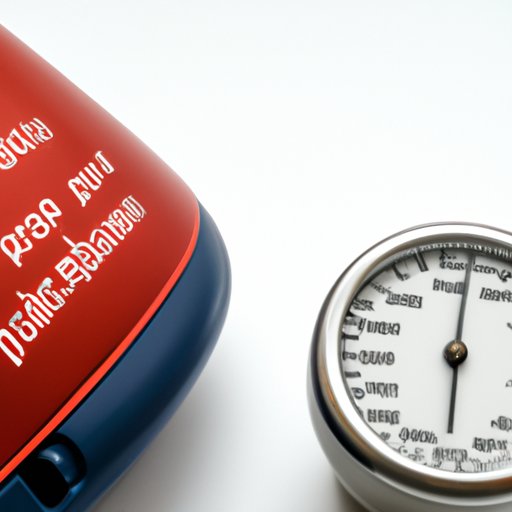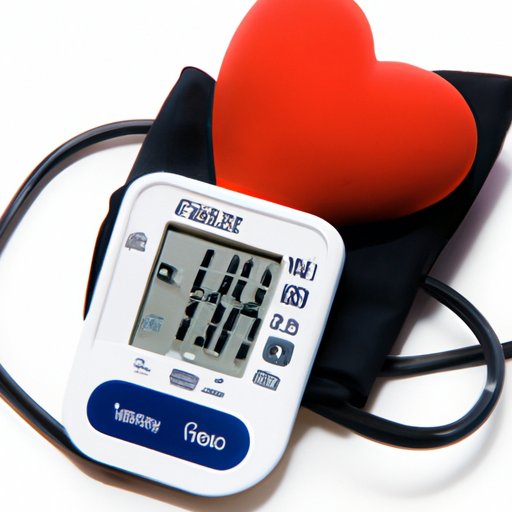Introduction
High blood pressure, also known as hypertension, is a common condition that affects millions of people worldwide. It occurs when the force of blood against the walls of your arteries is consistently too high. While it doesn’t usually cause any symptoms, high blood pressure can increase your risk of serious health problems such as heart attack, stroke, and kidney disease.
The good news is that high blood pressure is often silent but preventable. That’s why it’s essential to know your numbers and make appropriate lifestyle changes to maintain healthy blood pressure levels.
Blood Pressure 101: Understanding the Two Numbers
Blood pressure readings consist of two numbers: systolic and diastolic.
Systolic blood pressure measures the pressure in your arteries when your heart beats. It’s the top number on a blood pressure reading. Diastolic blood pressure, on the other hand, measures the pressure in your arteries when your heart is resting between beats. It’s the bottom number on a blood pressure reading.
When you get your blood pressure reading, the systolic value is stated first and the diastolic value is second, e.g., 120/80mm Hg. The units for blood pressure readings are millimeters of mercury (mm Hg).
Ideal Blood Pressure Numbers
According to the American Heart Association, the ideal blood pressure reading for adults is less than 120/80 mm Hg. Anything above this range is considered high and requires medical attention.
The Range of Blood Pressure Readings
Blood pressure readings are classified into four categories:
- Normal: 119/79 mm Hg or lower
- Elevated: 120-129/less than 80 mm Hg
- Stage 1 hypertension: 130-139/80-89 mm Hg
- Stage 2 hypertension: 140/90 mm Hg or higher
The Science behind Blood Pressure Readings: Decoding the Meaning of Systolic and Diastolic Numbers
The Role of the Heart in Blood Pressure Readings
The heart is a powerful muscle that pumps blood through your arteries to the rest of your body. Blood pressure readings are a way to measure the force of that blood as it flows through your arteries.
Via a complex network of neurons and hormones, your brain signals your heart to beat faster or slower according to the needs of your body. As the heart beats, it creates pressure that pushes the blood through your arteries.
Factors Affecting Blood Pressure Numbers
Several factors can impact your blood pressure readings, including:
- Age
- Race
- Gender
- Weight
- Dietary habits
- Physical activity levels
- Alcohol and tobacco use
- Family history of high blood pressure
The Consequences of High Blood Pressure
Chronic high blood pressure can damage your arteries and cause a range of health issues, including:
- Heart disease
- Stroke
- Kidney disease
- Vision loss
- Erectile dysfunction
The Importance of Systolic Blood Pressure: Understanding the Top Number
Definition of Systolic Blood Pressure
Systolic blood pressure reflects the amount of pressure in your arteries when your heart beats. It’s the top number on your blood pressure reading.
Impact of High Systolic Pressure on Health
High systolic blood pressure puts a strain on your heart and increases your risk of developing heart disease or stroke. It’s especially harmful to older adults because it shows the elasticity of arterial walls and mimics the arteries’ stiffness.
This condition, known as isolated systolic hypertension, is prevalent in people over 60 years. It accounts for around 90% of hypertension cases in this age group.
The Need to Monitor Systolic Blood Pressure
It’s important to monitor your systolic blood pressure regularly, especially if you’re over 60. As the heart muscle ages, it naturally loses some of its elasticity. It can pump blood effectively, but the arteries may not return to a relaxed state between beats.
That’s why systolic blood pressure is critical in diagnosing hypertension. It’s also important to monitor it as you age and adjust your lifestyle habits accordingly.
Focus on Diastolic: Why the Bottom Number Matters in Blood Pressure Readings
What is Diastolic Blood Pressure?
Diastolic blood pressure measures the pressure in your arteries when your heart is resting between beats. It’s the bottom number on your blood pressure reading.
Significance of Diastolic Blood Pressure
Diastolic blood pressure is a measure of how easily your heart can refill with blood between beats. A high diastolic reading can indicate underlying narrowing of the arteries, making it harder for your heart to pump blood.
This condition, known as diastolic heart failure, can cause your heart to become enlarged and less efficient at pumping blood.
Understanding the Relationship between Systolic and Diastolic Blood Pressure
Systolic and diastolic blood pressure readings are interrelated. An increase in systolic pressure usually precedes an increase in diastolic pressure. Chronically elevated blood pressure can lead to heart damage and other health issues, such as stroke.

Which Number is More Important in Blood Pressure Readings: Exploring the Pros and Cons
Argument for Systolic as the More Important Number
Some studies suggest that systolic blood pressure is a better predictor of heart disease and stroke risk than diastolic blood pressure. Because systolic pressure reflects your heart’s effort to pump blood, it’s often a better indicator of overall cardiovascular health.
Argument for Diastolic as the More Important Number
Other studies suggest that diastolic blood pressure is more important because it’s a measure of your heart’s ability to relax. High diastolic pressure can indicate underlying arterial damage, which can lead to long-term health problems.
Comparative Analysis of the Two Numbers
There isn’t a definitive answer to which number is more important in blood pressure readings because both are critical in understanding your overall cardiovascular health. For this reason, it’s essential to focus on both systolic and diastolic blood pressure readings in making an informed health decision.
Taking Control of Your Blood Pressure: Understanding the Relationship between the Two Numbers
Importance of Self-monitoring Blood Pressure
Self-monitoring your blood pressure can give you a better understanding of how your numbers fluctuate during the day and help you make informed decisions about your lifestyle habits. Several apps and devices in the market can help you track your blood pressure at home or on-the-go.
Lifestyle Changes to Improve Blood Pressure
Making simple changes in your lifestyle can help you maintain healthy blood pressure levels. Some of these changes include:
- Exercise regularly
- Eat a balanced diet
- Reduce your sodium intake
- Avoid tobacco and alcohol
- Maintain a healthy weight
- Manage stress
The Role of Medication in Managing Blood Pressure
Suppose lifestyle changes alone don’t improve your blood pressure readings. In that case, your healthcare provider may recommend medications such as diuretics, ACE inhibitors, or calcium-channel blockers, depending on the underlying cause of your hypertension.
Which Number Really Matters?: Navigating the Confusion Surrounding Blood Pressure Readings
Understanding the Complexities of Blood Pressure Readings
As we’ve seen, blood pressure readings can be complicated to interpret because they reflect different aspects of cardiovascular health.
The best way to make sense of blood pressure readings is to monitor both systolic and diastolic blood pressure readings and know what’s normal for you. Speak with a healthcare provider if you’re unsure of what your readings mean or want to make lifestyle changes.
The Importance of Speaking with a Medical Professional
While understanding blood pressure readings can be confusing, speaking with a medical professional can help you navigate the complexities and make sense of your readings. Your healthcare provider can help you make personalized lifestyle changes and develop a plan to manage hypertension if necessary.
Summary of Main Points
- Blood pressure readings consist of two numbers: systolic and diastolic.
- The ideal blood pressure readings for adults are less than 120/80 mm Hg.
- Systolic and diastolic readings are interrelated and important in determining overall cardiovascular health.
- Making lifestyle changes and monitoring blood pressure readings can help you maintain healthy blood pressure levels.
- Speaking with a healthcare provider is crucial in making informed health decisions regarding blood pressure management.
Conclusion
In conclusion, both systolic and diastolic blood pressure readings are important in understanding your overall cardiovascular health. While some studies suggest that one number may be more important than the other, they both play a critical role in determining your risk of developing heart disease, stroke, and kidney disease.
To take control of your blood pressure, monitor your readings regularly, make lifestyle changes, and speak with a medical professional to develop a personalized plan. Investing in your cardiovascular health today can reduce your risk of chronic health issues in the future.
Call to Action
Make monitoring your blood pressure a regular part of your healthcare routine. Utilize the various apps and devices in the market to track your readings and make informed decisions about your lifestyle habits. Speak with a medical professional if you’re concerned about your numbers and develop a plan to manage hypertension if necessary.
Final Thoughts
Ongoing research is shedding new light on how blood pressure readings can help us make informed decisions about our health. By understanding the significance of both systolic and diastolic numbers, we can make lifestyle changes and take control of our cardiovascular health. Remember to speak with a medical professional if you’re unsure about your readings or need additional support.
